Pleasant Gehman's Blog, page 5
October 7, 2014
CONNECTING THE DOTS: MAKING SMOOTH TRANSITIONS IN YOUR DANCE
 Photo by Maharet Christina Hughes
Photo by Maharet Christina Hughes Transitions are the unsung hero in dance.
They’re almost an unseen “missing link”, they are the lines that connect the dots, stringing together a bunch of separate movements and making them look cohesive. Good transitions add an unending flow, making our performance look polished and effortless. Sometimes our transitions are fancy and flowery, other times they’re as unnoticeable as a simple weight change…but they always need to be there. Without transitions, any dance would look stilted and jerky, simply a series of stationary movements.
When I first started dancing, the very idea of transitions totally confused me. Like many baby dancers, I was focused purely on technique. I didn’t understand the importance of transitions… and often, teachers don’t fully explain that, either. Many classes focus solely on drilling on stationary technique, or teach full choreographies to beginners, without stressing the mechanics of what is actually being done in the choreography. When this alone happens, a student can perform a full choreography, but might not be able to build a choreography (or an improvised piece) their own.
The purpose transitions serve are many, and once you become comfortable with their purpose and importance, they will seem a lot less esoteric!
Essentially, our dance transitions are a way of matching our movement and moods to the phrases in the music itself.
Transitions function as a preparation for our bodies to segue from one movement into another in a seamless and logical way. Basically, a physical transition involves making sure that you are in the correct position to make your next movement. A transition usually involves all of at least some of the following: weight placement, body angle and alignment, spatial movement, and embellishment. But transitions can also convey feelings to the audience. Quite often, the music we use in performance calls for a change of attitude on the part of the performer, so the dancer needs to use stage presence and facial expressions as well as body language to change with the mood of the music. In that case, an emotional transition needs to be made as well.
If you were to imagine your dance piece as a classical painting, then transitions would be the place where the colors in the painting are blended. If you didn’t have the transitions (or a mixture of colors in the painting) then your piece of art would be just a bunch of blocks of color, not a finished work. Well, maybe it’d be Modern Art… but I digress.
Another analogy would be to think of your dance piece as a story, or a book. In that case, transitions are the punctuation as well as the points of separation for new thoughts or idea that run through the entire narrative, connecting the plot-lines so that the story makes sense. Essentially, our dance transitions are a way of matching our movement to the phrases in the music itself, so we can better “illustrate” the song we are dancing to.
Here are some ideas that will help you out with incorporating smooth, flowing transitions emotionally and physically.
Weight Placement This is one of the most important facets of transitions, knowing your footing. Without proper weight placement, your dance is destined to fall apart. In order to avoid performing an odd (and unwanted) little jig as you move from step to step, or from phrase to phrase, be hyper-aware of your weight placement.
A good rule of thumb is: “What Goes Up Must Come Down”. In other words, if your weight is on your right foot, in order to make a seamless transition, you will step onto the left foot…and vice versa. This is especially important while turning! Drill your weight placement even if you think you are fine with it already.
Work With The Counts When I was a baby dancer, I was confounded that so many movements could be fit into eight counts… or sixteen, or thirty-two. I jut didn't get it, and always seemed to finish late, after everyone else was done. The problem was real, and the solution was simple, but it was assumed that everyone in the class would understand. What I didn’t know was that the transition in movement starts occurring one or two beats before a phrase is finished…and that concept was never explained to me! No wonder I was finishing late, I had no idea what was going on.
So, if a phrase is eight counts long, the transition to the next phrase will start at the sixth or seventh beat, not on or after the eighth beat.
Look For Clarification In Class Or Rehearsals Make sure you understand everything you can about the way a choreography- or a “follow the leader” type of improvisation works. Don’t be afraid to ask your teacher (or another dancer) to go over weight placement, phrasing, or a preparation for a turn. If you’re worried about holding up the class or rehearsal don’t be- chances are, you’ll be asking a question that many are wondering about them! And even if that isn’t the case, it’s always better to be performing correctly, so that the entire group looks uniform and together.
Analyze Music Without Dancing To It Take some time to get really familiar with your music. Sit with it, and analyze it; break the entire piece down into measures of eight counts.
After you’re comfortable with this, have another few listens and identify the musical changes themselves… you will start to be able to see how each musical phrase is a “paragraph” in your musical story.
Of course, do this exercise with the music you’ll be using in class or for your show, but also with music that you would probably never use onstage. At first it might seem like a big daunting task, but after a while, you’ll have that “A-Ha Moment”, and you’ll have fun breaking your music- or any music- down in this way.
Feel The Music The next step is become comfortable with it, really feeling it and recognizing exactly where the transitions will come. Remember to look for changes in the emotional attitude of the piece, such as a bridge that goes up into a sweeping crescendo, or pauses and full stops in the song.
The music itself will inform you, but by using your counts and sensing the mood of the composition, you will know when to physically begin your transition.
With practice, this will become almost intuitive, ingrained into your consciousness, and you will start being able to anticipate where and when your transitions will need occur, even if you’ve never heard that particular piece of music before.
#
Sunday, October 19th, 2014, Washington, DCI’ll be teaching a three hour mini-intensive on this very subject as part of the Raven’s Night weekend.“Go With The Flow: Musicality, Sensuality, Texture And Fluid Transitions” 3:30-6:30pm Epic Yoga1323 Connecticut Avenue NW Washington, DC 20036
More information & Registration here: http://ravensnight.com/princess-farhana-330pm/
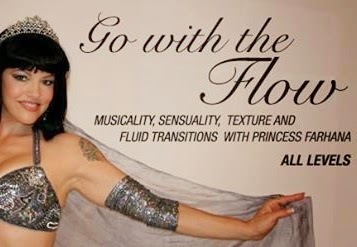
Published on October 07, 2014 14:39
October 1, 2014
DAMN YOU AUTOCORRECT...BELLY DANCE STYLE

I adore my iPhone, even though I’m… ahem… of the age where I can recall all too clearly thinking that FAX machines were sheer magic. In fact, when I got my phone, my teenage niece had to set my phone up for me, and I’m reasonably sure I’m only using it to a tiny fraction of it’s potential. There are many wonderful apps and tricks to be learned and used.
We all know that spell check and autocorrect is of the best – and worst- features on smart phones. There are the funny, odd word substitutions that autocorrect makes as a matter of course; for instance, a friend recently texted me asking if she could borrow my “oink” veil… and I instinctively knew she meant my pink one! And since I often use a lot of “colorful language” in my texts, my phone decides to substitute words like ducking instead of the he rhyming oath I’m attempting to type!
But I think really there needs to be a special Damn You Autocorrect site for belly dancers only.
If my own phone is any indication, many words that are “indigenous” to belly dancers – including common Arabic terms and casually used dancers slang- magically start appearing instead of the “every day” English words I’m trying to use.
I can’t be the only one with this problem, right?
For instance, when I was texting to a neighbor about our parking situation, the word “garage” became Ghawazee. She had absolutely no clue what I was writing about!
If I discuss grabbing a cab, “taxi” always turns into taxim, “have to” magically becomes hafla and when I attempt to write “ I said”, the word Saidi appears.
When I tried typing “infinite” autocorrect decided I was really trying to say infidel; “being” immediately becomes bling-bling and the word “because” routinely turns into beledi.
When texting about a dish I was bringing to a ( non belly dance) pot-luck party, “make some” became maksoum; the word “easy” it always becomes Egypt, “purchase” comes up as Persia and when I give directions to my house, “turn ” morphs into Turkey. The words "still" or "silly" become zills and whenever I write the word "about", it turns into Abdou ... as in Fifi!
Naturally, I’ve learned to live with these silly substitutions, but they still make me- and most of the people I’m texting-laugh out loud.The one thing I cannot understand though, is that no matter how many times I write my stage name, for some reason, autocorrect never thinks it’s valid.
The general public might think of me as Princess Farhana... but to my phone, I’ll always be Princess Farmhand!
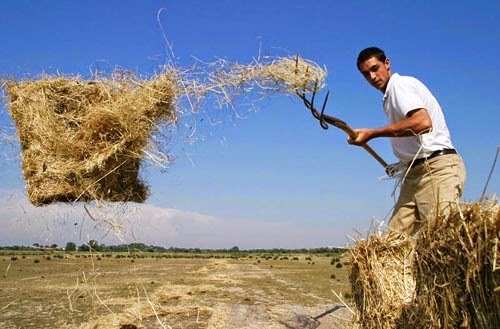
#
Get an autographed copy of The Belly Dance Handbook or my memoir Showgirl Confidential: My Life Onstage, Backstage And On The Road here:
http://www.princessfarhana.com/shop.htm
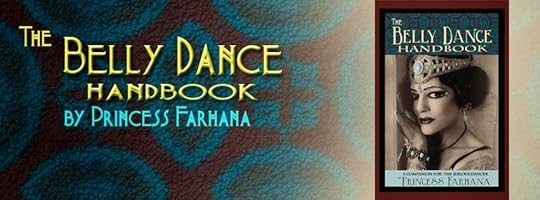 Photo and graphics by Maharet Hughes
Photo and graphics by Maharet Hughes
Published on October 01, 2014 12:58
September 28, 2014
DANCERS BACKSTAGE RITUALS: ALLI RUTH OF HELSINKI, FINLAND
 Alli Ruth by Atelieri O. Haapala, Helsinki, Finland Every so often, I’ll meet a dancer whose onstage persona is so completely unlike the way she is in real life, it really throws me for a loop. One moment we’re backstage acting like complete idiots, giggling over silly things while compulsively shoving carrot sticks into our mouths. Then, she performs a set so amazing, that when she finishes, I’m so blown away with utter fangirl appreciation, I almost feel too shy to talk to her! Alli Ruth is that kind of dancer. Even though we’ve been pals her for years, and I’ve seen her multiple times in ratty sweats with no make up, an Ace bandage wrapped around an injury, swearing like a truck driver, I can never quitereconcile her fun, down-to-earth true self with the preternaturally elegant creature I’ve just witnessed bringing the house down onstage. And not only that, in her real life, she’s a librarian! To see her performing classic American and Turkish style floor work is like having a private audience with a goddess!
Alli Ruth by Atelieri O. Haapala, Helsinki, Finland Every so often, I’ll meet a dancer whose onstage persona is so completely unlike the way she is in real life, it really throws me for a loop. One moment we’re backstage acting like complete idiots, giggling over silly things while compulsively shoving carrot sticks into our mouths. Then, she performs a set so amazing, that when she finishes, I’m so blown away with utter fangirl appreciation, I almost feel too shy to talk to her! Alli Ruth is that kind of dancer. Even though we’ve been pals her for years, and I’ve seen her multiple times in ratty sweats with no make up, an Ace bandage wrapped around an injury, swearing like a truck driver, I can never quitereconcile her fun, down-to-earth true self with the preternaturally elegant creature I’ve just witnessed bringing the house down onstage. And not only that, in her real life, she’s a librarian! To see her performing classic American and Turkish style floor work is like having a private audience with a goddess! Photo: Atelieri O. HaapalaAlli Ruth lives in Helsinki, Finland, where she teaches and performs her specialty-and passion- American Cabaret style belly dance. She herself calls what she does “AmCab Fusion”, because she isn’t nearly old enough to have ever performed this style back in it’s Seventies heyday!
Photo: Atelieri O. HaapalaAlli Ruth lives in Helsinki, Finland, where she teaches and performs her specialty-and passion- American Cabaret style belly dance. She herself calls what she does “AmCab Fusion”, because she isn’t nearly old enough to have ever performed this style back in it’s Seventies heyday!  As White Kali in a Desert Sin performanceAfter moving to Finland in 2010,she realized that dancers from across the continent of Europe had a hunger for this uniquely American style, so she began teaching what she’d grown up with as a dancer. She came to belly dance in 1998, in her native Los Angeles, learning from the masters of the American Cabaret (also known as Vintage Orientale) genre, including the late, great Diane Webber, whose unique style and considerable influence inspired another of Alli Ruth’s mentor’s, LA-based dancer Anaheed. Dance mother to many in Southern California, Anaheed invited Alli Ruth to appear with The Perfumes Of Araby, a troupe founded by Diane Webber. In 2001, through Anaheed, she met and began dancing with Elayssa of Desert Sin, a gloriously theatrical “alternative belly dance” troupe whose influence is still widely felt in the Tribal Fusion community, and as Alli Ruth says, “whether they realize it or not!”
As White Kali in a Desert Sin performanceAfter moving to Finland in 2010,she realized that dancers from across the continent of Europe had a hunger for this uniquely American style, so she began teaching what she’d grown up with as a dancer. She came to belly dance in 1998, in her native Los Angeles, learning from the masters of the American Cabaret (also known as Vintage Orientale) genre, including the late, great Diane Webber, whose unique style and considerable influence inspired another of Alli Ruth’s mentor’s, LA-based dancer Anaheed. Dance mother to many in Southern California, Anaheed invited Alli Ruth to appear with The Perfumes Of Araby, a troupe founded by Diane Webber. In 2001, through Anaheed, she met and began dancing with Elayssa of Desert Sin, a gloriously theatrical “alternative belly dance” troupe whose influence is still widely felt in the Tribal Fusion community, and as Alli Ruth says, “whether they realize it or not!”
 With Princess Benu in IstanbulShe has also seriously studied with other legendary AmCab performers such as Cory Zamora, Alexandra King and Princess Benu of Turkey, plus the Queen of Floor Work (and inventor of many of it’s staple moves) Anahid Sofian of New York City. Alli Ruth’s teaching and performing career abroad has been as busy as it has been fulfilling; though like any dancer worth her salt, she considers herself a student and constantly attends workshops, classes and private lessons. By doing this, she is also preserving a distinctive and exceptional American contribution to belly dancing.
With Princess Benu in IstanbulShe has also seriously studied with other legendary AmCab performers such as Cory Zamora, Alexandra King and Princess Benu of Turkey, plus the Queen of Floor Work (and inventor of many of it’s staple moves) Anahid Sofian of New York City. Alli Ruth’s teaching and performing career abroad has been as busy as it has been fulfilling; though like any dancer worth her salt, she considers herself a student and constantly attends workshops, classes and private lessons. By doing this, she is also preserving a distinctive and exceptional American contribution to belly dancing.Here, in her own modest words, is how Alli Ruth prepares for her show-stopping performances:
“I try to do as much of my makeup and prep at home, especially if I don’t know the backstage conditions, or don’t have a backstage at all. This too allows me to change my mind, for example about an eye shadow color at the last minute. I enjoy socializing backstage and would rather relax and talk to, or assist other dancers than be stuck in the mirror. It also makes more time for warming up. My warm up consists of lots of relaxed shimmies, “African Stretch” for the spine (Diane Webber used to make us do it every class), large loose hip circles, lunges and ankle, shoulder and wrist circles.
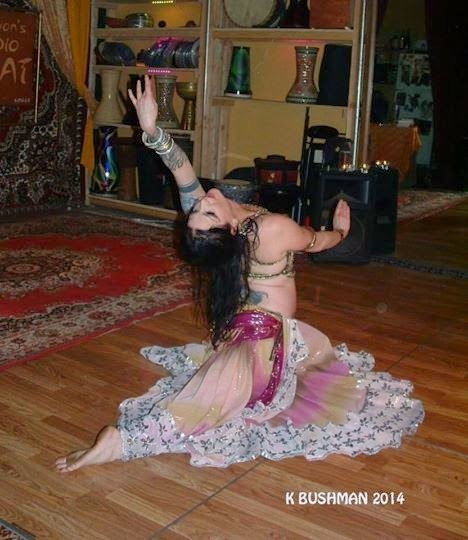 Alli Ruth at Sutdio Iqaat, LA photo: Kat BushmanMy costuming style is what they used to call “Mixy Gypsy” so I never wear the same exact ensemble. I also never know exactly what I’m going to wear in advance. I’m famous for being frantic about “what to wear” and changing my mind about details up until the last minute. My breast size fluctuates greatly, leading to hasty alterations. My lifesaver mom is accustomed to my begging her to stitch bra hooks, and over the years I’ve taught a couple boyfriends how to use a needle and thread. Because I improv, I also have the opportunity to change my music up until the last minute, particularly if the organizer doesn’t need it in advance. What I’m getting at is that I have total ADD, which I struggle with when it comes to show prep.
Alli Ruth at Sutdio Iqaat, LA photo: Kat BushmanMy costuming style is what they used to call “Mixy Gypsy” so I never wear the same exact ensemble. I also never know exactly what I’m going to wear in advance. I’m famous for being frantic about “what to wear” and changing my mind about details up until the last minute. My breast size fluctuates greatly, leading to hasty alterations. My lifesaver mom is accustomed to my begging her to stitch bra hooks, and over the years I’ve taught a couple boyfriends how to use a needle and thread. Because I improv, I also have the opportunity to change my music up until the last minute, particularly if the organizer doesn’t need it in advance. What I’m getting at is that I have total ADD, which I struggle with when it comes to show prep. I’ve learned to not make or watch recordings of myself within 3 days before the show as it inevitably results in a self-critique that will cause me to change my mind, if not fall apart entirely. Also, to have many bra hook options on both the back and neck straps of my bras. I of course have a prepped gig bag and even extra, extra things that other dancers may have forgotten themselves (Belly dance karma!).
Because I do floor work, one of the most important things is to know the condition and material of the floor to help determine the bottom half of my costume. Harem pants can get pulled by carpet (I’ve heard of dancers literally pantsing themselves) but carpet can cause serious burn on a bare leg. Some settings may have floor that is too harsh-such as pavement, be too small or placed in such a way the audience wouldn’t see you on the floor. Sometimes, floor work won’twork which factors into my music selection.
I’m always way more nervous in the days before the performance and on the day of the show than I am when I’m about to go on. The main thing I do in the moments before coming out to dance is taking deep breaths and remind myself, it’s simply about sharing a dance. I try to remember that nobody cares so much about me that they’re going to go home and think for days about how I may have messed up; they have their own lives and concerns and nobody wants me to fail. I try to quiet my ego and dance for the joy of it. I think of all the happiness and fun I’ve experienced myself when watching other dancers and the gratitude I have towards them for this. It’s simply my turn to do the same for others, to share. This really keeps me calm and ensures a good experience.
After my performance, it’s like I got something out of my system and just wants to return to being “Al”-my nickname amongst friends. I almost always, immediately tear off my bra and throw on a t-shirt -or a comfy cover up if I’m coming out from backstage, maybe crack a beer or pour a glass of wine.
I like dancing most at private events, where I can come both in and out as the belly dancer …and the mystique of the backstage, behind-the-scenes stays in my own home.”
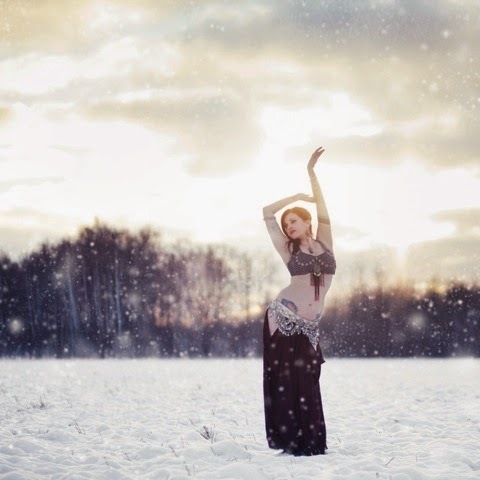 The Snow Queen: photo by Irina Alanko
The Snow Queen: photo by Irina Alanko##
Sunday, October 4, 2014Hardcore Floor: Old School AmCab and Classic Turkish Floor Work With Alli Ruth You’ll learn ascents, descents, back bends, layouts, and some nearly extinct (and very wild) Turkish moves and Rom gestures for floor. Floor work for both drum solo and taxim will be explored. 1:30-4:30pm Dance Garden 3191 Casitas, Ste 112 LA CA 90039 ONE DAY ONLY, $50.00 To register, contact Devillaraks@gmail.com
##
The Belly Dance Handbook: A Companion For The Serious Dancer is now available wholesale for dance teachers and studios. To find out about wholesale order, visit www.princessfarhana.com and click on the “email” button at the top right of the home page.
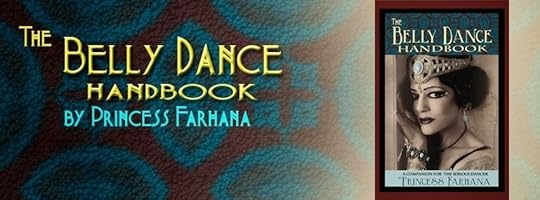
Published on September 28, 2014 18:36
September 22, 2014
FALLING INTO AUTUMN : A CHANGE OF SEASON CHECK LIST FOR DANCERS

On the eve of the Autumn Equinox I wish you a very Happy First Day Of Fall!
Even though it’s sunny and hot here in my native Los Angeles and doesn’t feel like autumn at all, every Solstice, I get the urge to prepare for the new season dance-wise. And for those of you in places where the weather actually changes according to the season, it’s even more imperative!
The first thing I do is go through my costume closet and take a look at everything to see what needs mending, alterations or some other kind of attention. I get out my sewing kit and re-do hooks and snaps, repair any loose beads or dropped hems, and see if anything needs to be washed or dry cleaned. I check my dance shoes to see if they need to be repaired or replaced, steam or iron my veils, and add new elastic to my finger cymbals, and replace the cedar chips in the air-tight boxes where I store my feather fans.
Most of us have costumes that we wear less often during summer- like those with sleeves, more coverage, or stage creations hade of velvet…now’s the time to bust out those beauties, cause they’ll come in handy during these colder months.
I also re-stock my gig bags and class bags with new supplies for the chilly season, adding a heavier cover-up plus things that come in handy in drafty dance studios or back stage, like leg warmers and a light dance sweater or hoodie. I make sure each gig bag includes a little emergency kit with bobby pins, safety pins, needles and thread, Band-Aids, feminine protection, pain reliever tablets, and stuff I blow through constantly, like breath mints, hair spray and body glitter.
Fall is a great time to check your stage make up, too. This might not be pertinent for Goth chicks, but as the seasons change, your skin tone is probably changing, too! The transition from being a sun-kissed, beach babe to your non-summer complexion means that you’ll need to address your skin products and foundation.
Now is the time to get a slightly thicker moisturizer or serum to protect your skin from the cold and rain- might as well get a jump-start on it, right? And you'll probably have to blend a couple of tones of foundation to get your “transitional” skin evened out. I usually take a clean new travel-sized container and mix the two colors directly into the container. Remember that for stage work, if your foundation is a shade or two darker than your actual skin tone, it won’t look odd; it’ll just make you appear healthy and robust.
At the change of seasons, I also throw away any cosmetics that have run their course- especially items like mascara or creamy eye shadow or eye make up primer. Because these are wet and can attract bacteria every time you use them, in order for these products to not potentially cause an infection, their life span is usually only three months, anyway. I date mine with a sharpie pen and get rid of them at the three-month mark.
Right now is also a fantastic time to get a jump on your holiday season gigs, too!
Show producers and private parties begin booking for the holidays well before the end of October…because if they don’t, the prime days- especially weekend nights between Thanksgiving and the middle of December, will already be taken!
Send out emails with descriptions of what shows and service you can offer during the holidays now. Make the tone friendly and professional, and alert your previous clients as well as sending an email (or hard copy promotional package) to venues like nightclubs, theaters, restaurants, banquet halls and to individual event planners in your area.
Tune up your technique and start making your warm-ups a little longer and more thorough; the cold weather can seize muscles and some of us feel the damp in our joints, too. Start setting choreographies for your holiday gigs now… and take the next few weeks to make sure that your special holiday costumes are either gig-ready, or at least that construction has started!
If you teach, this is also a fantastic time to contact the studio where you’re work- or where you’d like to work, to discuss class and workshop plans and time slots for 2015!
And as of right now, it’s only a few days until October! Can you believe it? I sure as hell can’t!
Now is also the time to practice saying NO…because in a couple of weeks, everyone and their baby sister are going to be hitting you up to borrow your expensive stage wear to use as Halloween costumes!
#
Get yourself a signed copy of The Belly Dance Handbook: A Companion For The Serious Dancer here: http://www.princessfarhana.com/shop.htm
Published on September 22, 2014 15:30
September 7, 2014
BREAKING BAD: GETTING RID OF PESKY PERFORMANCE HABITS
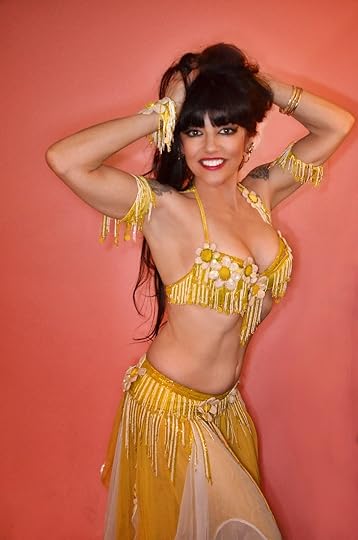 I made an "executive decision" to play with my hair for this picture!
I made an "executive decision" to play with my hair for this picture! Photo: Maharet Hughes
We all love to watch a dancer who looks effortless and relaxed onstage because it’s a joy to see. This type of natural performance allows audience members to just sit back and become enthralled by the dancer’s personality and connection to the music. But this air of ease and confidence is often something many performers struggle with, because before we actually hit the stage, we’re hyper from performance adrenalin and nervous energy! Usually this type of laid-back grace isn’t natural, it’s a learned skill, which has been honed and perfected, just like any other type of technique!
One of the things that drives me (and other audience members, whether they are professional dancers or not) crazy when watching a show is a performer who carries over bad habits from their rehearsals or classes into their performances. It's also the bane of every dancers existence- cause at some point in our career, we all have had bad habits that presented themselves in our performances. Dancers of all levels often have difficulties controlling unconscious nervous tics and stressed out gestures when they’re on stage, whether it’s holding tension in their jaws, a glassy “concentration face” kind of stare or mouthing the counts of the music. We’ve all seen it!
My own go-to nervous gesture used to be constantly playing with my hair… and not in a sexy, come-hither way! I looked more like an agitated fifth grader about to take a spelling test than a relaxed and capable professional dancer.
It took me a long time to break that habit…and it also took a lot of cussing out loud at myself in the mirror while I practiced! But the work was worth it, I finally laid that unconscious tic to rest, and now the only time I play with my hair onstage is if I do it intentionally.
To remedy our habits, we need to be vigilant during our classes, practice sessions and rehearsals so that we don’t take these audience distractions onto the stage with us!
Habits- in any form- are difficult to break.
These unconscious gestures are have become automatic, and the reason they get repeated is twofold. First of all, our habits are almost always something that has been done constantly; whether it is physical, mental or emotional, habits are learned through repetition.
To illustrate this, think of a good habit (like your basic dance posture) and you’ll get the idea. Prior to your study of dance, you didn’t go about your daily activities standing straight and tall, with the muscles in your abdomen engaged, a lifted ribcage and your shoulders held back and down…. did you?
Nope, you learned this posture!
And it took a damn long time to get to the point where this stance became normalfor you! But once you got used to standing in dance posture, it became one less thing to keep track of, thereby allowing your brain to focus on more important issues…like executing difficult technique or getting your timing and phrasing down.
Secondly, many of these habitual behaviors have become comfortable, reliable and somewhat pleasurable, because for whatever reason, they make us feel calm and peaceful. Think of a child sucking it’s thumb and you’ll get the idea. A self-soothing habit (whether it is shopping compulsively, always having a glass of wine with dinner or making odd grimaces onstage) triggers the chemical dopamine in our brains, which in turn activates our brain’s Reward Center. Why does a dog beg? He knows he will get a treat! It's a habit.
Why did I always used to twirl my hair onstage? Cause it felt good to do that in a stressful environment…playing with my hair was a self-soothing “treat”, but it sucked because I not only did it in public, during performance, but I didn’t even realize I was doing it, because I wasn’t thinking about it!
Once you understand these two concepts, any habit will become a little easier for you to break. You’ll still need will power, and you’ll still need to really re-wire your brain to change the habit, but it can be done!
Here’s how:
IDENTIFY YOUR BAD HABITSThe best way to do this is to watch taped performances and practice sessions.
Some of the problem areas you notice will be physical, such as hunched shoulders, sloppy arm paths, or not finishing each and every movement fully.
Other habits will be more emotionally or mentally based, like mouthing counts in the music, looking at the floor, or or making a face while reacting to an on-stage mishap.
Remember that you’re not watching your performance to tear it apart, but so that you can become a better dancer! Take an objective detachment, become your own “casual third party observer”. Watch your tape a few times and make brief notes on what you’d like to change or improve upon, and then let it go, don’t do anything about it for a couple of days. Watch it again, and see if your reactions to the performance are about the same, or less or more than they were when you initially watched it. Take notes, and compare the notes from both observation sessions. Now, what you need to work on will be clear.
TAKE BABY STEPS Rome wasn’t built in a day, and your onstage habits weren’t either!
Once you’ve identified the habits you’d like to break, you can start re-training yourself to avoid them in performance. Most experts agree that it takes considerable time and dedication to discontinue any sort of habit… depending on the individual, breaking a habit or correcting a nervous tick could take anywhere from a couple of weeks to six months. It’s a process whereby you’re actually re-wiring your brain!
PRACTICE SELF-AWARENESS Watch yourself like a hawk in class or rehearsals, be vigilant and merciless…. By that, I mean in noticing and correctingthe bad habits, not by emotionally beating yourself up! Remember, you are doing something positive here! Remind yourself just before you go onstage that you are NOT in any way, shape or form, going to give into falling back to your old habits. Tell yourself out loud if you need to! You might look like a nut in the dressing room, but it’s way better than looking compulsive or nervous on stage!
IT TAKES A VILLAGE Well, maybe not really… but getting an objective, neutral party to help break your habits is a fabulous idea! Discuss your habit-breaking goals with your instructor, troupe leader, show director or a friend, asking them to point out when you engage in the practices that you want to discontinue. It will help to have another set of eyes on you, and it will also make you feel a little more accountable and supported.
REWARD YOURSELF Go all Pavlovian - every time you make it through a class, practice or performance without engaging in the habit you want to break, give yourself a little reward. A sweet treat, a new pair of earrings, whatever! And when you’ve broken your habit once and for all, your biggest reward will be a better performance.
You can do it!
#
Get a signed copy of The Belly Dance Handbook: A Companion For The Serious Dancer here:
http://www.princessfarhana.com/shop.htm

Photo and graphics: Maharet Hughes
Published on September 07, 2014 17:45
August 12, 2014
DANCERS ON THE INTERNET, PART TWO: #HASHTAGS 101
 The mighty mighty #hashtag
The mighty mighty #hashtagIn my last blog post, I mentioned using social media to network and promote your dance classes and events… and I gotta say that one of my very favorite tools for doing just that is the hashtag.
Most people know what a hashtag is; it’s that “number sign”, the tic-tac-toe symbol hat looks like this: #
But even though most of us are familiar with hashtags, many of us don’t know how to use them at all, let alone use them to their fullest advantage!
I worship at the altar of hashtags- and after you find out how to use them, you probably will, too!
Last year at the annual Raven’s Night belly dance event in Washington, DC as many of us were sitting around talking shop into the wee hours, I was asked to give an explanation on hashtag use. Though it was extremely informal (and just a little tinged with the wine we were drinking!) Illuminated the idea of how hashtags, function. After that, many of us jokingly started saying the word “hashtag” in our speech, in front of the words that would be hashtagged if they were being typed on a social media site! It turned into such an in-joke that weekend that a group of us who were already actually got small sized hashtag symbols tattooed on our bodies!
So, this is the way hashtags work: if you type the hashtag symbol (#) in front of a word on social media sites, the hashtag and the word will turn blue, indicating that whatever word you type (such as #dancer) will turn into a searchable term. That means anyone who is hunting for the word “dancer” will be directed to your post!
Now, let’s look at hashtag use in terms of promotion.
When posting an event flyer or photo on a social media site, many people just leave it at that, using the image only. Their online “friends” will see the image, and can “like” it. That right there is good…but it could be better.
If you use hashtags correctly, everyone who is interested in whatever you #hashtag will see it! I’m gonna use one of my own online flyers here as an example.
Post the image, and then type the information in your post to go along with it, like this:
 Photo & Graphic: Maharet Hughes
Photo & Graphic: Maharet HughesTIARA TUESDAYS: #PRINCESSFARHANA ’S #BELLYDANCE#SHOWCASEAugust 26, 2014 Special Guests #Jenna & #Stephanya #tarotcardreadings by Natalie#MOUNOFTUNIS7445 ½ SUNSET LA CA 90046 Dinner: 7pm show: 8pm North African Feast $17.50 per personReservations a Must! (323) 874-3333#Orientaldance #rakssharqi #tribalfusion #cabaret #LA #Hollywood #entertainment #girlsnightout #danceperformance
Promotion-wise, adding all the info clearly typed is a good idea anyway. But I’ve also hashtagged pretty much anything that could pertain to my event as well, including really obvious things like cities, neighborhoods, the names of the special guests ( so anyone who is a student or fan can see them) as well as specific types of dance or things that people might be looking for if they want a night out in #losangeles!
There is so much information on this specific “post” that it would only fly on Facebook. It would be way too long for Twitter, which only allows 140 characters per post, so in that case, I would just use #bellydance, not the whole shebang!
If I wanted to post this on #Twitter, I would click on the image on #Facebook ( aka #FB) which will then come up with all the information I have typed in to go along with it, copy the URL, and paste it into my Twitter post, adding something short like:
“ Come to my #bellydance show 8/26 in #LA ".
If you are posting on #instagram ( also known as #IG) you have a lot more space for text and can use #unlimited #hashtags
Got it?
#Hashtagsare a #huge part of #socialmedia, and also a really #important #promotionaltooltoo! Once you’ve mastered the concept, you can even have #fun with them… like this:
#learnsomethingneweveryday #ihearthashtags #hashtagabuse
Published on August 12, 2014 14:47
July 30, 2014
FOUR MISTAKES DANCERS MAKE ON THE INTERNET
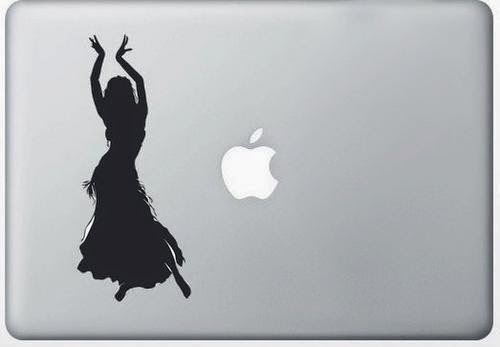
Often, there is so much administrative work that needs to be done to keep up a healthy dance career that I find myself thinking,
“ Shouldn’t I be dancing instead of sitting at a my computer?”
In a perfect world, the answer would be a big, resounding yes. But in the real world, most dancers are the stewards of their own career.
We’re our own booking agents, public relations staff, travel agents, and interns. Most of us don’t have “management” to rely on, we’re our own bosses…and that means we also wind up doing all of the work! For many dancers, this part of their career is something they don’t bargain for when they were dreaming of dancing professionally. But doing this often tedious work is really what enables us to be successful at what we really want to do, which is dance!
Lately, I’ve been getting a lot of emails from dancers approaching me with marketing and promotion questions. I decided to do a series on this blog answering some of the most frequently-asked questions I receive, so here’s Part One: Four Mistakes Dancers Make On The Internet.
1) YOU DON’T HAVE A WEBSITE
I’ve said it before and I’ll say it again: you need a professional website.
It’s important for many reasons- it allows people to see what you look like, read your bio, access dates you’ll be performing and classes or workshops that you’re teaching, buy your products and services, and to get a feel for what you do. The people who visit your site will be able to “see” you, to contact you, and to take you seriously, realizing that you truly are an artist and businessperson, not just a dabbler. It doesn’t need to have all the latest bells and whistles, but it does need to impart the who, what, where and why of your dance career.
“But I have a Facebook page!” I can hear you cry, “Isn’t that good enough?” No, it’s not. Not if you’re serious about your career.
Ok, a Facebook page is better than nothing, but you still need a website! Your website and your Facebook page should be linked. If for some insane reason you don’t have a Facebook account, this brings us to:
2) YOU DON’T HAVE A PRESENCE ON SOCIAL MEDIASocial media is awesome in general, but it’s especially great for connecting with your fans, students, potential students and/or sponsors or for selling costumes, engaging in spirited discussions, shop talk and conversations about dance history, and for joining groups that will inform you about your area of interest. These interactions are so important for our careers!
If you aren’t actively involved in social media, you’re doing your dance career a serious disservice.
Social medial equals free marketing!
Facebook, Twitter and Instagram really are where it’s happening, they’re terrific promotional tools which can link you to others who share your interests. I know it sounds trite, but it’s true. If you don’t have accounts on these top sites, take the time to set one up and learn how to use them. They’re fun, yes, but they’re also extremely important to you as a professional. Students, fans, show producers, casting directors and potential clients for private parties look for dancers on social media all the time. You can get hired, get professional advice, learn about auditions, acquire students ,new fans and buy costumes via social media.
If you’ve been holding off on this, now’s the time to explore it…which brings us to:
3) NOT USING SOCIAL MEDIA TO YOUR ADVANTAGE
Many dancers literally shoot themselves in the foot while using social media.
One common mistake is to set up a page on (any) social media site, and then let it die a long, slow death by not doing anything with it. Ok, so you set up a Facebook, Twitter or Instagram page…and you can’t see the big deal about it. You’re not so happy with it because you have like, four followers…. and you’d much rather be playing Candy Crush Saga or Bubble Witch or whatever the hell is the new addictive time-waster. Right? You can’t see what’s so great about having a dance-oriented professional page, cause nothing is happening.
But did you think to yourself “If I Build It They Will Come?”
Nice fantasy, but that isn’t how it works! If you’re using social media for marketing, you need to put the necessary time into your page, or…pun intended…it’s gonna go belly up really quickly.
“But I don’t have the time!”
This is a common complaint many dancers have.
Make the time- remember, social medial equals free marketing!
Do some posts and interactions with your morning coffee… you can even set an alarm so you don’t go over ten or fifteen minutes and get sucked into a rabbit hole. “Like” a few pages or make some comments while you’re waiting for dance class to start… log on from the dentist’s office, while the baby’s asleep, at a dog park, a show, the airport or in line at the grocery store …where, I daresay, you’re probably already shimmying up a storm, practicing as your groceries are being bagged!
In order to get an audience, you have to engage an audience. Like courtship, you have to woo people to your page. Invite people to your page(s) and make sure there is something interesting and fun for them to enjoy…so they will be sure to check back for more updates.
Don’t blast out event promotions non-stop, it will be off-putting to your followers…though you do need to be consistent with announcing a gig or a class, cause posting one time isn’t going to cut the mustard. People visit many different pages, and their newsfeed is getting updated by the second by all of their friends, as well as all the pages they like.
That means your event post will come and go in the blink of an eye, so you definitely have to post multiple times. Just don’t over-do it, and please, for the love of god, don’t tag people who wouldn’t be interested, or whom you know won’t be able to come to your show. Inviting people from other states or countries won’t help your event- cause they will not be able to attend and will just get annoyed cause you’re being spammy.
Engage with others by “liking” and commenting on their status posts, be personal and personable! Make sure your social media interactions find a balance between the fun stuff and hard-core promo or people will start tuning out. Lots of pictures are always good, in fact, sometimes I’m kinda shocked by how few dancers post pictures…cause they’re pretty much like digital calling cards! If you look sparkly and appealing, others will react favorably. The phrase “Every Picture Tells A Story” comes to mind.
3) OVER-SHARING ON SOCIAL MEDIA Ok, so I’ve just told you to post a lot of stuff…pictures, event announcements, videos, etc. But if you have a fan page or group set up just for your dancing, please keep it “on topic”. A really common mistake- and one that makes many people actually feel embarrassed for you- is to “overshare” or post TMI , the abbreviation for “too much information”.
If you’re running a dance oriented page, people don’t need ( or want!) to know that you’re having your period, fighting with your significant other, having a rough day emotionally, fell off the wagon, or that a relative died…or you broke a nail.
Your professional page should reflect your professional dance career.
It isn’t a tell-all site, or a place to get virtual hugs. Use your personal page for that kind of post…if, indeed you really and truly want to post all your dirty laundry on the internet.
Presumably the reason you made a dance page on any social media site is because you are in the midst of having a dance career. It’s doubtful that you would walk into your day job and complain about any of this stuff, right? If you want your dancing to be your day job, then you need to behave professionally when you’re online.
There are a few exceptions to this rule. For example, if something went horrendously wrong at a gig, but it turned out to be a funny story- something that many dancers can relate to- then go ahead and post away! Similarly, if your addiction is glitter, buying or making costumes, or something like that- as opposed to some sort of illegal controlled substance- go ahead and post about it…cause everyone will relate to it! And if something terrible happened, like your sprained your ankle and need to cancel some gigs, go ahead and post that. It will be a way of letting everyone know (all at once) why you aren’t showing up for a show or shows. And in a tough situation like this, which again, every dancer can relate to it, you will probably be pleasantly surprised at how supportive and generous the dance community can be!
#
Watch for Part Two in this series, which will help you find your way in navigating social media sites to their greatest advantage.
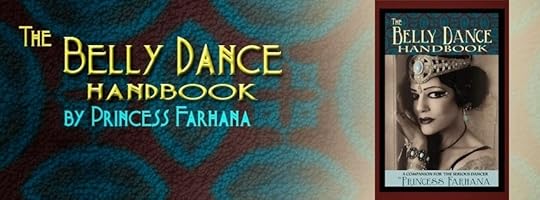
Purchase an autographed copy of The Belly Dance Handbook: A Companion For The Serious Dancer here:
http://www.princessfarhana.com/shop.htm
Published on July 30, 2014 22:46
July 21, 2014
The ROYAL PALACE STATE OF THE UNION ADDRESS, SUMMER 2014
 Dancing to Issam's drum solo at The Baladi Tour CD Release Party, Studio Iqaat, LA Photo: Maharet Hughes
Dancing to Issam's drum solo at The Baladi Tour CD Release Party, Studio Iqaat, LA Photo: Maharet Hughes Hope you’re having a terrific summer! Mine has been jam-packed with lots of fun stuff and new projects… seriously, I feel so blessed to be able to have my job be something I love to do!
I’ve been working on follow-ups to The Belly Dance Handbook, and Showgirl Confidential, which wills both, be out sometime in the middle of 2015. And there is talk of a new instructional DVD- keep your fingers crossed, you’re gonna love this one!
This summer has been non-stop dancing and touring to teach and perform by myself as well as with Issam Houshan on our BaLAdi Tour. We’ve hit Eugene, Oregon, Wichita, Kansas and El Paso Texas, and we’ll be teaching an performing a lot together next year, nationally and internationally. Like The Baladi Tour on Facebook: https://www.facebook.com/PrincessAndIssam?ref=br_tf
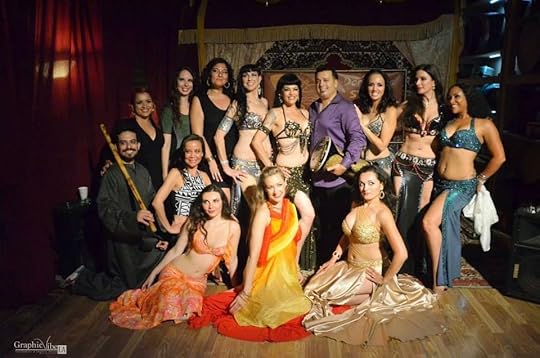 Baladi Tour Party Performers, photo: Maharet Hughes
Baladi Tour Party Performers, photo: Maharet HughesOur new Baladi Tour CD just came out; the release party was off the hook! Some of the best dancers in LA performed, many of who are internationally known, like Rania, Aubre Hill and Stefanya (all former members of Belly Dance Superstars) DeVilla and Nathalie, Olu, Adrianne and Qabila Folkloric Dance Company, directed by Aubre.
If you missed it, the party streamed live and will be up on the internet for the next two days at www.justin.tv/iqaat Get the CD here: http://www.princessfarhana.com/shop.htm
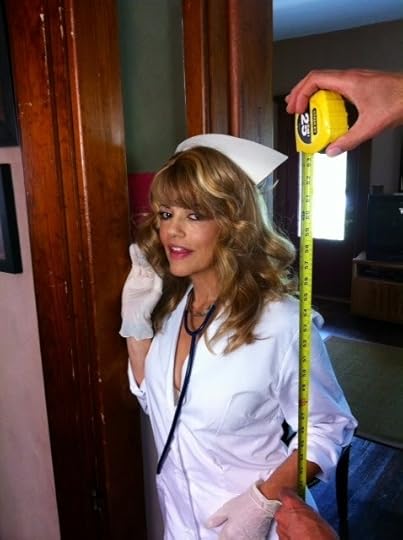 In between workshops in Oklahoma, The Theatrical Belly Dance Conference in New York City and Cairo Shimmy Quake in LA, (both festivals were amazing!) I shot a movie last month with director Steve Balderson; called “Hell Town”…it’s a horror movie about a faux soap opera, and very tacky-on-purpose. I play a very naughty and murderous nurse in the film…and I got to have blonde hair! I also got to watch myself get killed in the movie- cause I died off-screen. That was an experience, I tell you!
In between workshops in Oklahoma, The Theatrical Belly Dance Conference in New York City and Cairo Shimmy Quake in LA, (both festivals were amazing!) I shot a movie last month with director Steve Balderson; called “Hell Town”…it’s a horror movie about a faux soap opera, and very tacky-on-purpose. I play a very naughty and murderous nurse in the film…and I got to have blonde hair! I also got to watch myself get killed in the movie- cause I died off-screen. That was an experience, I tell you! Photo: Maharet Hughes
Photo: Maharet HughesAs of right now, I have space for two dancers in my Star (Em)Power Professional Development And Mentorship Program. This highly individualized course of study will be fine-tuned to your individual needs and help you make your dance goals and dreams turn into reality. It can be accessed from all over the world, we’ll work on your goals through live Skype lessons and discussions, video reviews, and a plan of action, with homework assigned via email. Candidates are generally advanced intermediate through professional level dancers.There is an audition process- for more information on this opportunity, please click here: http://www.princessfarhana.com/classes.htm
Here are some up coming dates for the rest of the summer, hope to see you someplace soon!
AUG 1-3, 2014 MEMPHIS, TENNSSEE Show at The Rumba Room with Amani Jabril, me and live Arabic with Jonatan Gomes Derbaq & friends music plus local dancers! Friday Aug 1, 303 S. Main Street, Memphis info: https://www.facebook.com/events/724554480934163/ Workshops in Memphis Aug. 2-3Info & registration: http://am7207.wix.com/raqmemphis
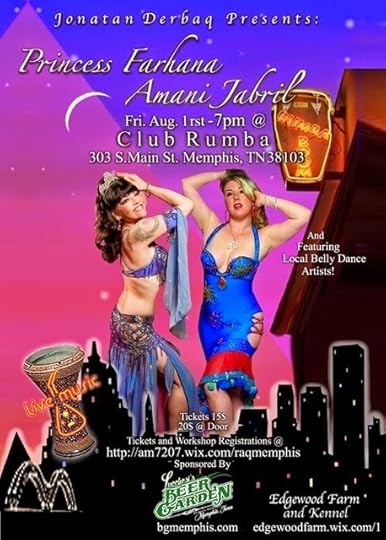
AUG 8- 10, 2014 ATLANTA, GEORGIA Book reading & signing party for:“SHOWGIRL CONFIDENTIAL” & THE BELLY DANCE HANDBOOKAtlanta Fusion Belly Dance 500 Bishop Street North Suite F-6 Atlanta, 30318 21 or older, wine will be served with price of admission $7Info: amani@amanijabril.com or 404-550-4692
AUG. 9 & 10 Atlanta, GA Summer Extravaganza! Belly dance & burlesque workshops all day and into the night at Atlanta School of Burlesque, 1745 DeFoor Place, Suit D Atlanta…. There will be a show on Sunday Aug. 10th, too, where I’ll be performing both styles! Info: https://www.facebook.com/events/215640701978723/

AUG 16 & 17, 2014, BILLINGS, MONTANA Yellowstone Valley Belly Dance FestivalInfo: http://www.spiralskiesbellydance.com/yvbdfestival.htm
AUG. 24, 2014, SUNNYVALE, CA (SF Bay Area) Assuit Fest: workshops & book release party for Dawn Devine’s new book on Assuit, “The Cloth Of Egypt” info: http://www.davina.us/blog/2014/07/assiut-fest-workshop-and-dance-party/
#
 Get a signed copy of The Belly Dance Handbook here:
http://www.princessfarhana.com/shop.htm
Get a signed copy of The Belly Dance Handbook here:
http://www.princessfarhana.com/shop.htm
Published on July 21, 2014 14:18
July 17, 2014
HOW TO SELECT SWORDS FOR BELLY DANCE PERFORMANCES
 Photo by Maharet Hughes/GraphicVibeLAFor years, dancers from all over the world have been emailing me about how to pick out a sword and where to find the perfect sword for their style or experience level! And in the past week alone, I've gotten three emails on this subject!
Photo by Maharet Hughes/GraphicVibeLAFor years, dancers from all over the world have been emailing me about how to pick out a sword and where to find the perfect sword for their style or experience level! And in the past week alone, I've gotten three emails on this subject!
Here are some sword selection points to consider:
Finding the perfect sword for belly dancing can be a daunting task. This is especially true if you are about to purchase your first scimitar, or if you are shopping for a sword on the Internet, and don’t have the opportunity to try it out in person.
For someone who is just beginning to dance with scimitars , the best are those that are perfectly balanced, height-proportionate, and not really light but also not a big heavy weapon, because you may need to increase your strength and work up to that. Medium size well-balanced dance sabers are pretty inexpensive, so once you get used to working with them, if you want a flashy, heavier sword, it wouldn’t break your bank to buy one after a few months of getting used to your "starter" sword- and that way, you will always have a spare on hand.
You want a saber that'll stay on your head without rocking, and one that won't kill your neck and upper muscles until you build up the necessary stamina and strength. Also, durability figures in- you want it to stay balanced if- and when- it gets dropped, and believe me it will get dropped!
Your selection will depend on a few different factors: aesthetics and personal taste is important. One dancer might want a gleaming new-looking sword that shines under the stage lights, while another may desire a weapon that looks more rustic, like it’s an authentic antique. There are also many shapes and sizes of swords to choose from, ranging from those with relatively thin blades without much curve to blades that have a deadly, sharp curve and get thicker at the end, towards the tip. The way the hilt (handle) looks and feels is also a factor. Some swords have a very utilitarian, simple-looking hilt with a flat cross guard, others are highly decorated, and ranging from ornately carved rounded or pointed pommels to dragonhead motifs. I even have a sword whose handle features a cast-brass figure of a leaping jaguar chasing a rabbit. If your sword features a cupped cross guard and you are left-handed, make sure it fits your hand properly, or get an “ambidextrous” sword with a flat cross-guard.
Your sword choice will also depend on your size. A larger sword might be too heavy or dwarf a smaller performer onstage, while a smaller, shorter sword might look comical on a taller, more statuesque dancer.
More importantly, your sword selection should be based on how experienced you are, as well as in the strength of the muscles in your neck, upper back, shoulders and arms. Remember, you are going to be balancing it on top of your head and will have to remain very stable while doing so, and that takes strength. You will also be arcing and swinging the sword while it’s held in your hand, and so it needs to be light enough for you to easily handle it.
Another factor is price: swords can range from about $25.00 to $500.00, depending on quality, size, whether the sabre is custom-made or antique...but don’t think you need to make a huge investment in order to get a decent sword.
There are many inexpensive options on the market today, so if you are a beginner and unsure of what to get, pick a slightly smaller, relatively affordable sword- you can always work your way up to a larger, heavier and more expensive one later.
All swords balance differently, depending on the weight of the blade, the heft and angle of the hilt-or in laymen’s terms, the handle area- which includes the cross-guard and pommel, which is the decorative bolt at the top of the handle. When buying a sword for dancing, pick one that stands up straight on it’s edge (the blade edge) and doesn’t flop over flat. There are many scimitar options on the market today which are made strictly for dancing and are balanced already, so you will not have a problem finding a sword that suits you and your unique needs.
When shopping for a sword in person, check it out and find the median balance point by testing the blade on the top of your wrist, then try it on your head. The balance point of the sword itself won’t be dead center; it will be more towards the sword’s handle. The optimum balance point on your head will be different depending on what type of sword you are using as well as what is easiest for you. For swords, my balance point is just in front of the center of my head- but everyone’s skull has a different shape. With some practice, you will find what is your most comfortable spot.o it becomes gummy will add a little traction. Some dancers glue a very thin strip of sandpaper along the edge at the balance point. This will not be visible from the stage but it does help to “catch” on your hair. Some types of swords come with grooves already cut into them at the balancing point- but I myself don’t find this helpful- usually the grooves are too wide for them to be able to work properly. And there are also dancers who don’t use anything, just a bare blade. Again, this is your choice.
And one last word to the wise: even if a sword was made specifically for dancing, it still has the potential to injure you. Remember to warm up completely before you work with your scimitar. If you feel it sliding while you are dancing, take a moment, remove the sword and replace it back to your original, comfortable balance point, and then proceed with your act.
The main thing to remember when rehearsing or performing with swords is: SAFETY FIRST!
#
The article you have just read is an excerpt from THE BELLY DANCE HANDBOOK: A COMPANION FOR THE SERIOUS DANCER ... get an autographed copy here: http://www.princessfarhana.com/shop.htm
I also have three instructional sword dancing DVDs featuring more hints, tips, sword tricks, choreographies, and costumed sword performances on that page : )
Here's a link which features many great dancing swords…tell them The Princess sent you!http://www.bellydanceprops.com/scimitars.php
Published on July 17, 2014 11:53
July 4, 2014
STAGE MAKE UP FOR OUTDOOR AND DAY TIME GIGS
 Impersonating a mermaid at White Sands National Park, New Mexico, using the make up concepts mentioned below
Impersonating a mermaid at White Sands National Park, New Mexico, using the make up concepts mentioned belowStage makeup for dance needs to be powerful, bright and heavy, so the audience can see your features clearly. But now that summer is here, many of us are performing outdoors, and that’s a whole different animal!
I’ve gotten many requests lately asking for a guideline to daytime gigs where you will be performing up close or in the sunlight, like at an afternoon party, a fair or a street festival…so here are my tips for looking your best before dark.
During the day, you’ll need less make up than for a large stage or a dark nightclub, but you still need to apply more – and different- makeup than you’d wear on the street. This could, of course, mean using more liner or applying powder shadow a little darker and a vivid shade of shade of lipstick… but there’s also more to consider.
Begin your make up application with sunblock.
You’ll definitely need it, and should be using it every day, anyway. There are many non-greasy formulas on the market today made just for use on the face, so invest in one of them. I like to use sun products formulated for babies, because they are the least irritating, but I also like Neutrogena’s sunblock, too. And a word to the wise: make sure to cover – at the very least- your arms, neck, chest and torso with sunblock, too, cause sunburn and tan-lines in the pattern of your costume are not attractive!
After your sunblock has dried, you need to apply foundation-even if you don’t wear it inreal life- because it will make your complexion appear poreless and perfect. Since you won’t be on a theatrical stage, you could use a sheer formula or a tinted beauty balm or BB cream, but in either case, you’ll need to powder over it, to set it, cause you’ll be sweating a lot at an outdoor gig! For work onstage, many performers like to use a foundation that is a shade or two darker than their natural skin tone, because it makes their face appear brighter, more robust and healthy under the harsh stage lights. I would definitelysuggest this for an outdoor gig as well, because the sun can wash out your features just as much as stage lighting does!
Go over the perimeters of your face- forehead, cheekbones, and jawline- with a matte bronzing powder, both to contour and to make your face look healthy and glowing. Iridescent, sparkly or glittery bronzers are best saved for evening.
Color in the apples of your cheeks (only) with a vivid color: rose or berry tones for fair skin, coral or reds with an orange undertone for olive or darker skinned performers.
As for your eyes, you’ll need them to be really deeply colored and noticeable, but you’ll also want to stay away from flat black or muddy browns that will make you look haggard under direct sunlight. Nice russet tones and rich, chocolate browns look pretty on everybody. Again, steer away from pearly or irridescent hues, go for matte shades. A great option is to line your eyes with navy blue. It looks good on everything and makes the whites of the eyes appear brighter. Then do your lids in the brown shades, and don’t forget a thin pearly white highlight just under your brows.
For daytime gigs, I stick with powders and gel liners only. I never use cream blush or eye shadow, and I skip any sort of pencil, because all of these formulas tend to melt, smear and crease in summer sunlight. I don’t even use eyebrow pencils- too waxy. I fill in my brows with powder, using a small slanted brush. And as for brows: since I am dark haired, I use black onstage, but for day time gigs I use a much lighter brown, because in direct sunlight, black brows say “Groucho Marx”, not beautiful dancer!
If you don’t like wearing false eyelashes, then you must use waterproof mascara…or you’ll wind up looking like Alice Cooper! Pile on a few coats of it, leaving ample time for each layer to dry. But false eyelashes are way more foolproof for outdoors gigs. I use what I call my “daytime audition lashes”. They’re short but thick, and define the eyes really well, making harsh, heavy liner way less necessary.
As for lips, matte formula lipsticks are much better for day work than shiny ones like slick glosses or softer, more easy-to-melt products. Select a lip color in a bright “natural” shade, like a blue red (makes the teeth appear whiter) a youthful rose pink or a nice peachy-coral tone. Even if you’re dark skinned, stay away from anything too dark, like burgundy, brown or taupe. Apply the lipstick, blot your lips on a tissue, powder over your lips with a translucent powder, re-apply the color and blot again for maximum staying power. If you want to give the illusion of lustrous lip gloss, dip the pad of your finger into the same pearly white eye shadow you used as a brow highlighter, and apply a dot of it to the center of your lower lip, which will mimic the pretty sheen of lip gloss, but will stay in place, and won’t be greasy.
Since you’ll be outside, fun accessories like big blingy earrings, glittery bindis and rhinestones around the eyes all look completely fabulous sparkling in the sun. But it's not like I have to tell any of you readers to wear more bling, right?
One last thought- Remember to keep your costumes for daytime and outdoor gigs family friendly.
Remember to bring some dancing shoes… because pavement, stages , sand and even the grass and especially Astro Turf get very hot when direct sun has been shining on them for hours, and you could literally get burned. Shoes are mandatory.
Have fun Day Dancing in the great outdoors!
#
For more tips on make up, costuming, gigging and dance in general, get an autographed copy of the Belly Dance Handbook here: http://www.princessfarhana.com/shop.htm
 Photo & Design by Maharet Hughes, GraphicVibeLA
Photo & Design by Maharet Hughes, GraphicVibeLA
Published on July 04, 2014 15:50
Pleasant Gehman's Blog
- Pleasant Gehman's profile
- 16 followers
Pleasant Gehman isn't a Goodreads Author
(yet),
but they
do have a blog,
so here are some recent posts imported from
their feed.



